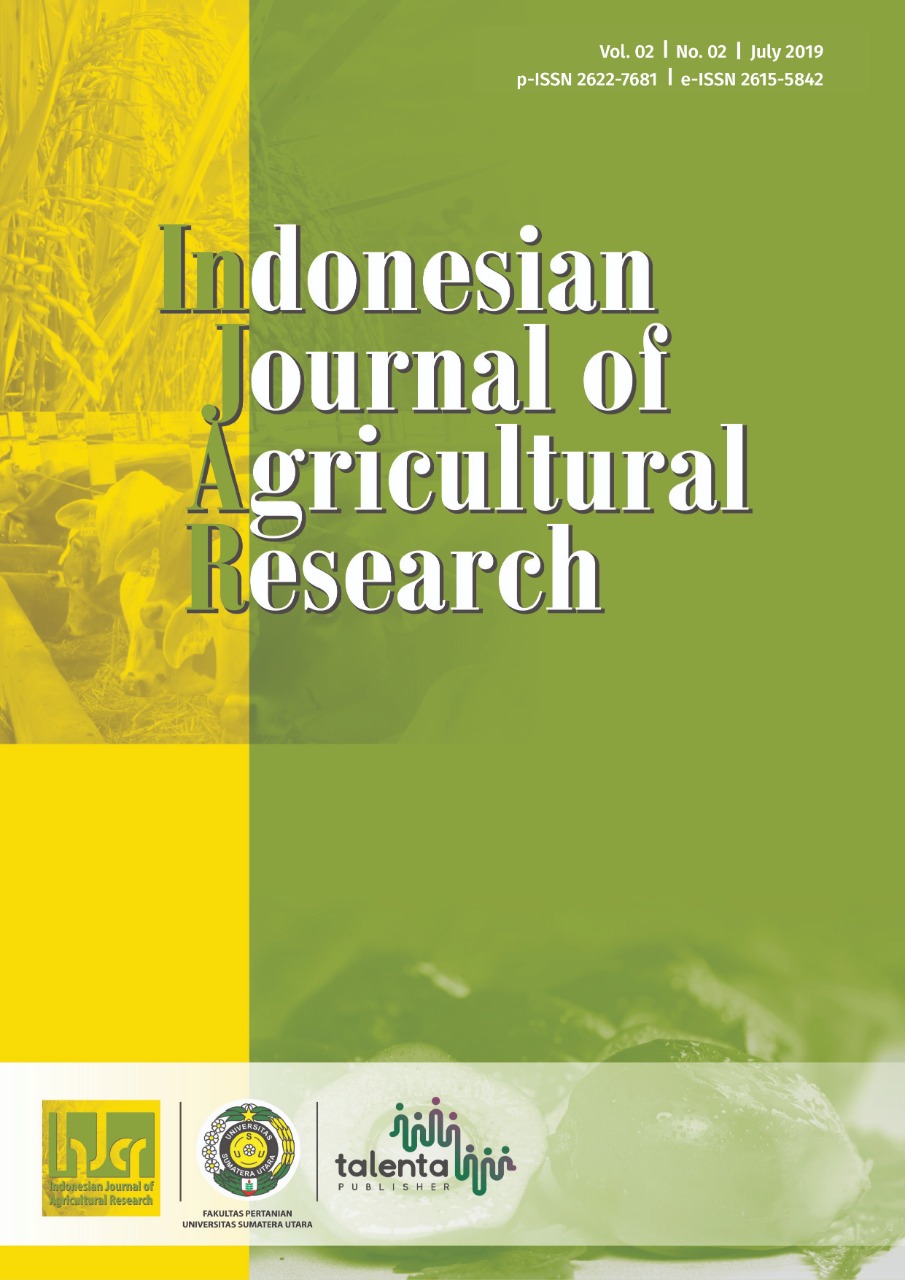Screening of Fungi from Oil Palm Rhizosphere in Peat Soils and the Potential as Biological Agents against Ganoderma boninense
DOI:
https://doi.org/10.32734/injar.v2i2.918Keywords:
fungi, oil palm, rizosphere, screeningAbstract
One of the diseases that attack oil palm plants is stem rot disease. Control efforts that can be done is to use rhizosphere fungi from oil palm plants in peat soils. This study aimed to select fungi from rhizosphere of oil palm plants in peat soil based on morphological characteristics and test their potential as biological agents against Ganoderma boninense. This research was conducted by exploration, observation and experiment by using complete randomized design (RAL). The parameters observed were macroscopic characteristics of fungi from oil palm rhizosphere, disease severity index, fungus inhibition power from oil palm rhizosphere to G. boninense, colony diameter and growth rate of high antagonist rhizosphere fungus, hyperparasitic type of fungus from rhizosphere of oil palm plant with G. boninense and the morphological characteristics of fungi from high antagonist rhizosphere in macroscopic and microscopic. The results showed that 12 rhizosphere fungi isolates and 4 isolates were antagonist to G. boninense. Isolate J5 has a high antagonist power of 70.26% and is a genus Trichoderma, isolate J7 belongs to the genus Trichoderma, isolate J10 genus Aspergillus and isolate J12 genus Mucor.
Downloads
References
Central Bureau of Statistics, “Statistics Indonesia Oil Palm Plantations from 2015 to 2017,†Directorate General of Plantation, Jakarta, 2017.
Department of Oil Palm Plantation, “12384.85 hectares of Riau Plantation crops pests,†Antara Riau.com, 2014. [Accessed: June 11, 2017].
A. W. Tri, M. I. Pinem and Y. Pangestiningsih, “The ability of the soil fungus Ganoderma suppressive against bon,inense on oil palm plantationsâ€, Journal Agroecotechnology, vol. 5, no. 3, pp. 707-715, 2017.
M. Murali, K. N. Amruthesh, J. Sudisha., S. R. Niranjana, and H. S. Shetty, “Screening for plant growth promoting fungi and their ability for growth promotion and induction of resistance in pearl millet against downy mildew disease,†Journal of Phytopatology, vol. 4, no. 5, pp. 30-36., 2012.
Barnett and Hunter, Illustrated Genera Of Imperfect Fungi: Imperfect Fungi, Minneappolis: Burgers Publishing Company, 1972.
C. A. Worosuryani and A. W. Priyatmojo, “The ability of fungi isolated test of sand land as PGPF (Plant growth promoting fungi),†Journal Agrosains, vol. 1, no. 9, pp. 179-192, 2006.
W. Otten, D. J. Bailey, and C. A. Giligan, “Empirical evidence of spatial thresholds to control invasion of fungal parasites and saprotrophs,†New Phytologist, vol. 163, pp. 125-132, 2004.
S. Purwantisari and B. H. Rini, “Test Phytoptora infestant antagonist fungal pathogens causing late blight and potato tuber using Trichoderma spp. Local isolates,†Journal biome, vol. 11, no. 1, pp. 24-32, 2009.
E. Yulianto “Evaluation of the potential of some fungal agent antagonists in inhibiting pathogenic Fusarium sp. in maize (Zea mays L.),†Faculty of Agriculture, University of Bengkulu, 2014.
C. P. Kubicek and G. E. Harman, Trichoderma and Gliocladium: Basic Biology, Taxonomy and Genetics, Taylor & Francis e-Library. pp. 278, 2002.
S. Fety, Khotimah, and Mukarlina, “Test antagonists local isolate rhizosphere fungi against phytophthora sp. isolated from the stem tan (Lansium domesticum Corr.),†Journal Protobiont, vol. 4, no. 1, pp. 218-225, 2015.
B. L. Batzing, Microbiology: an Introduction. Brooks, London: Thomson Learning, inc., 2002.
I. M. Sudarma and D. N. Suprapta, “Potential fungal antagonist derived from banana plant habitat with and without symptoms of fusarium wilt to control Fusarium oxysporum f Cubense in vitro. The Excellence Research Udayana University, pp. 161-166, 2011.
S. Matroudi, M. R. Zamani, and M. Motallebi, “Antagonist effects of three species of Trichoderma sp. on Sclerotinia sclerotiorum, the causal agent of canola stem rot,†Egyptian Journal of Biology, vol. 11, pp. 37-44, 2009.
M. Tambingsila, “Identify and test the effectiveness of rhizosphere fungi of cocoa plants as their potential as controlling antagonists (Phytophthora palmivora Bult.) which cause cocoa fruit rot,†Jurnal AgroPet, vol. 13, no. 1, pp. 12-23, 2016.
D. Sunarwati and R. Yoza, “Kemampuan Trichoderma dan Penicillium dalam menghambat pertumbuhan cendawan penyebab penyakit busuk akar durian (Phytophthora palmivora) secara in vitro,†Seminar Nasional Program dan Strategi Pengembangan Buah Nusantara, 2010.
W. Sari and E. Setiawanto, “Potential banana rhizosphere fungi as a biocontrol agent against fungus Fusarium oxysporum f.sp cubense causes banana wilt disease,†Agroscience Journal, vol. 1, no. 2, pp. 37-42, 2015.
M. Hutabalian, M. I. Pinem, and S. Oemry, “Test antagonism test some saprophytic and endophytic fungi of banana against Fusarium oxysporium f. sp. cubens in laboratory,†Jurnal Online Agroekoteaknologi, vol. 3, no. 2, pp. 687-695, 2015.
T. Watanabe, Pictorial Atlas of Soil and Seed Fungi, Edition 2th. USA: CRC press, 2002.
Downloads
Published
How to Cite
Issue
Section
License
Copyright (c) 2019 Indonesian Journal of Agricultural Research

This work is licensed under a Creative Commons Attribution-ShareAlike 4.0 International License.



















